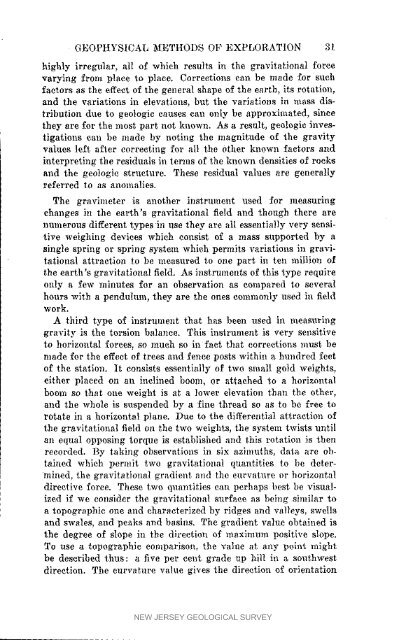Bulletin 54. Geophysical Methods of Exploration and their ...
Bulletin 54. Geophysical Methods of Exploration and their ...
Bulletin 54. Geophysical Methods of Exploration and their ...
You also want an ePaper? Increase the reach of your titles
YUMPU automatically turns print PDFs into web optimized ePapers that Google loves.
GEOFHYSICAI_ METHODS OF EXPISORATION 3l<br />
highly irregular, all <strong>of</strong> which results in the gravitational force<br />
varying from place to place. Corrections can be made for such<br />
factors as the effect <strong>of</strong> the general shape <strong>of</strong> the earth, its rotation,<br />
<strong>and</strong> the variations in elevations, but the variations in mass distribution<br />
due to geologic causes can only be approximated, since<br />
they are for the most part not known. As a result, geologic investigations<br />
can be made by noting the magnitude <strong>of</strong> the gravity<br />
values left after correcting for all the Other known factors <strong>and</strong><br />
interpreting the residuals in terms <strong>of</strong> the known densities <strong>of</strong> rocks<br />
<strong>and</strong> the geologic structure. These residual values are generally<br />
referred to as anmnalles.<br />
The gravlmeter is another instrument used for measuring<br />
changes in the earth's gravitational field <strong>and</strong> though there are<br />
numerous different types in use they are all essentially very sensitive<br />
weighing devices which consist <strong>of</strong> a mass supported by a<br />
single spring or spring system which permits variations in gravitational<br />
attraction to be measured to one part in ten million <strong>of</strong><br />
the earth's gravitational field. As instruments <strong>of</strong> this Wpe require<br />
only a few minutes for an observation as compared to several<br />
hours with a pendulum, they are the ones eommonly used in field<br />
work.<br />
A third type <strong>of</strong> instrument that has been used in measuring<br />
gravity is the tm'sion balance. This instrument is very sensitive<br />
to horizontal forces, so much so in fact that corrections must be<br />
made for the effect <strong>of</strong> trees <strong>and</strong> fence posts within a hundred feet<br />
<strong>of</strong> the station. ]t consists essentially <strong>of</strong> two small gold weights,<br />
either placed on an inclined boom, or attached to a horizontal<br />
boom so that one weight is at a lower elevation than the other,<br />
<strong>and</strong> the whole is suspended by a fine thread so as to be free to<br />
rotate in a horizontal plane. Due to the differential attraction <strong>of</strong><br />
the gravitational field on the two weights, the system twists until<br />
an equal opposing torque is established <strong>and</strong> this rotation is then<br />
recorded. By taking observations in six azimuths, data are obtalued<br />
which permit two gravitational quantities to be determined,<br />
the gravitational gradient <strong>and</strong> the curvature or horizontal<br />
directive force. These two quantities can perhaps best be visualized<br />
if we consider the gravitational surface as being similar to<br />
a topographic one <strong>and</strong> characterized by ridges <strong>and</strong> valleys, swells<br />
<strong>and</strong> swsles, <strong>and</strong> peaks <strong>and</strong> basins. The gradient value obtained is<br />
the degree <strong>of</strong> slope in the direction <strong>of</strong> maximum positive slope.<br />
To use a topographic comparison, the value at any point might<br />
be described thus: a five per cent grade up hill in a southwest<br />
direction. The curvature value gives the direction <strong>of</strong> orientation<br />
NEW JERSEY GEOLOGICAL SURVEY

















